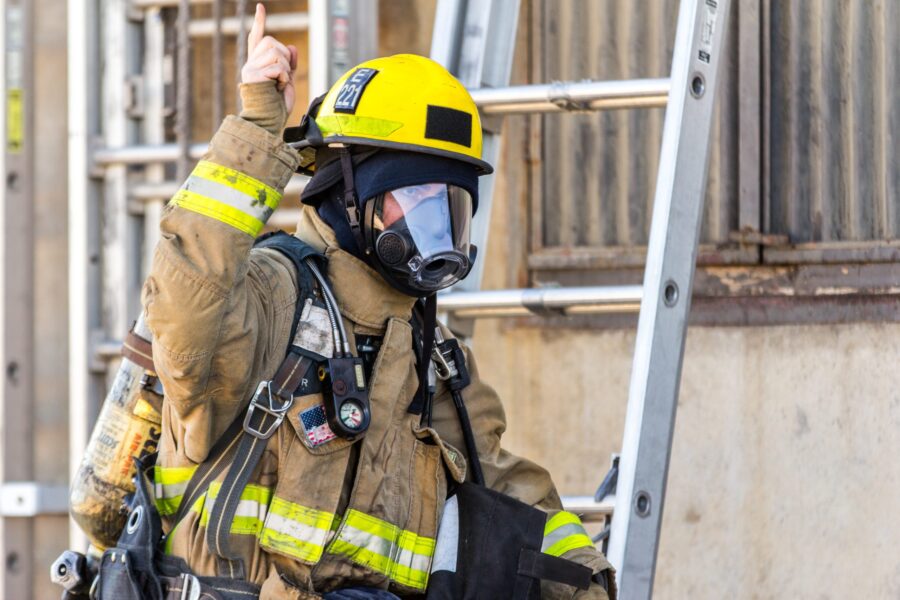The COVID global pandemic lays bare the consequences of when our leaders fail to lead and fulfill their most solemn duty—protecting those they are supposed to serve. Our president and every member of Congress could learn a great deal by better understanding what public safety officials in my town and in towns across the country do every day. I live in a small, rural Massachusetts town east of the Connecticut River, with a population of just under 2,000. My two adult children, Jonah and India, serve on the town’s volunteer fire department. And I couldn’t be prouder of my children or grateful that that department is led by a dedicated Fire Chief who has served the town for over two decades.
The chief, an exemplary leader in every sense of the word, shows through his leadership the importance of good decision-making and honest and effective communication. If there was ever a stickler for details, the chief is it. He and his crew are prepared. They train constantly going over procedures and protocols, roles, and responsibilities. They have clear lines of command and decision-making processes. When they respond to a fire, a medical emergency, or a car crash they know what to do and orders from the chief— or whoever is in command at the scene—are unambiguous and communicated clearly and consistently. The chief faces the truth, handles the truth, and tells the truth – a trait common in strong and effective leaders
In contrast to the leadership exemplified by our town’s public safety officers, we do not see strong leadership in the White House. Here in my community and within my own family, the failures of the Trump administration are becoming all too real.
During this COVID crisis, President Trump’s leadership-by-Tweet, near daily flip flopping of messages, lying, and the president’s petty, childish treatment of local and state elected officials is the antithesis of leadership and effective communication.
The Trump Administration’s leadership failures are being compounded by the grossly negligent lack of federal preparation and planning for this crisis – and is being felt very close to home right now. Seven days ago, my son Jonah responded to a medical emergency call. He treated a resident in our town who has since tested positive for the virus. But Jonah can’t get tested for the virus until he shows signs of illness. Why? Because our federal government was woefully unprepared and now virus testing is being rationed—unless of course you are rich or famous.
So, Jonah can’t find out if has the virus and is in quarantine. As a result, he can’t serve with the fire department and go on calls and protect our community. What happens when other members of the department are exposed? What if all of them are? How many thousands of other first responders in this country are in a similar position?
The realities of the COVID-19 pandemic bring to mind other global catastrophes and our vulnerability to them. Imagine how potentially catastrophic it would be to have this kind of federal-level leadership during a global military crisis – particularly one involving nuclear-armed nations. Recall President Trump’s saber rattling and name calling with North Korea’s leader Kim Jung Un back in September, 2017 when he threatened to “totally destroy North Korea.” We were one tweet from what could have been a major war on the Korean peninsula. Or, pause for a moment to ponder what might have occurred if the Trump administration was in power during 9|11 or during the Cuban Missile Crisis.
A key to dealing effectively with the pandemic, or any crisis, is being prepared by having the equipment and resources to deal with the situation at hand. The United States has not stockpiled what it needs while pushing through huge increases in our military budget. So at a time when our medical facilities don’t have nearly enough N-95 masks, respirators, or Personal Protective Equipment (PPE) our country is spending $40 billion-plus annually to maintain, re-furbish, and build new nuclear weapons we hope never to use —and plans to spend some $1.5 trillion over the next 30 years rebuilding and maintaining our entire nuclear arsenal of bombs, missiles, submarines and bombers.
Many of these new systems are completely redundant and unnecessary as the U.S. has more than 4,000 nuclear weapons in its arsenal, most of which are many more times destructive than the bombs the U.S. dropped on Hiroshima and Nagasaki 75 years ago. This nuclear spending spree is making us less safe and is contributing to a renewed global nuclear arms race. Nations should be doubling down on cooperation to address shared threats, like the pandemic, not figuring out better ways to kill each other.
When Congress starts to grapple with how to pay for the $2 trillion stimulus package that was just passed and gets back to debating this and future year budgets one hopes that the huge increases in nuclear spending and the $700 billion we spend annually on military spending will receive careful scrutiny. This scrutiny is imperative so that paying for this crisis does not fall to future generations and we prioritize federal policies and spending that facilitates caring for and protecting people, meets actual human needs, and confronts real threats.
It’s a matter of when—not if—we will experience another global pandemic. This pandemic has again proven what we thought impossible is very much possible. Nuclear war is no different. History is littered with nuclear close calls and this very day the United States is one bad decision away from war with any number of countries. The impacts and consequences of a so-called limited nuclear exchange would be exponentially worse than what we are experiencing today in terms of death and health, as well as economic and environmental impacts.
But the United States can and must prevent nuclear war and should take many other steps in addition to fundamentally re-ordering our national spending priorities. How can we prevent nuclear war? We can establish a policy that we will never use nuclear weapons first. We can take our nuclear weapons off of hair trigger alert. We can change the current policy that gives sole decision making authority over nuclear weapons to the president. And importantly we should embrace international cooperation – versus militarization—as the guiding, essential principle of our national security doctrine and Washington decision makers must demonstrate more effective leadership, re-evaluate the threats that confront us and reprogram dollars and invest in diplomacy to face them.
As a parent I am terrified and angry. As a public policy advocate and servant, I am resolute as are so many of my colleagues and UCS activists. We can and must do better—and we will.
The featured image in this blog is courtesy Matt Chesin/unsplash.

